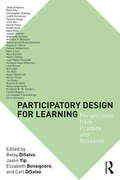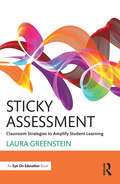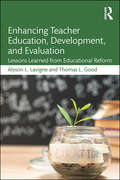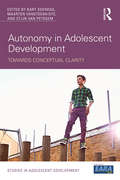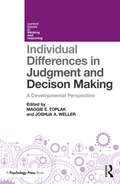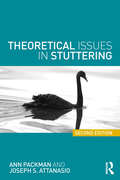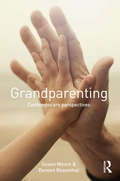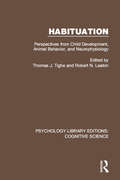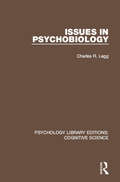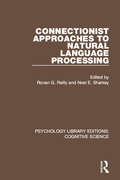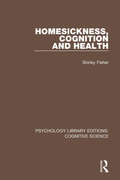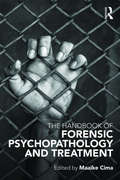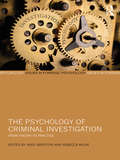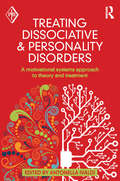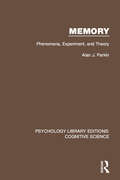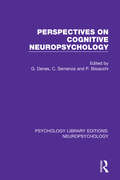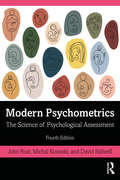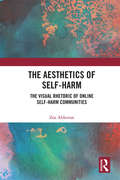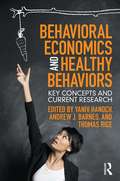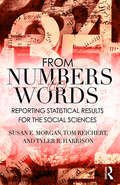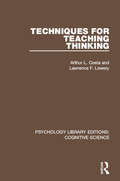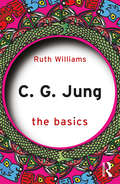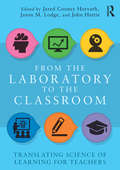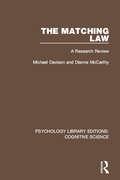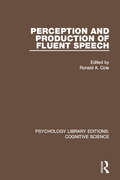- Table View
- List View
Participatory Design for Learning: Perspectives from Practice and Research
by Betsy Disalvo Carl Disalvo Elizabeth Bonsignore Jason YipParticipatory Design is a field of research and design that actively engages stakeholders in the processes of design in order to better conceptualize and create tools, environments, and systems that serve those stakeholders. In Participatory Design for Learning: Perspectives from Practice and Research, contributors from across the fields of the learning sciences and design articulate an inclusive practice and begin the process of shaping guidelines for such collaborative involvement. Drawing from a wide range of examples and perspectives, this book explores how participatory design can contribute to the development, implementation, and sustainability of learning innovations. Written for scholars and students, Participatory Design for Learning: Perspectives from Practice and Research develops and draws attention to practices that are relevant to the facilitation of effective educational environments and learning technologies.
Sticky Assessment: Classroom Strategies to Amplify Student Learning
by Laura GreensteinSticky Assessment is a straightforward guide to assessment, designed to demystify assessment and to give teachers the tools they need become better assessors. Translating the latest research into a concise and practical volume, this book helps teachers to monitor student learning, make assessment engaging and meaningful for students, and to use assessment that improves rather than merely measures learning outcomes. With examples from classroom teachers and exercises designed to help teachers think through their processes, this book will be an invaluable and lasting resource for classroom teachers.
Enhancing Teacher Education, Development, and Evaluation: Lessons Learned from Educational Reform
by Alyson L. Lavigne Thomas L. GoodEnhancing Teacher Education, Development, and Evaluation examines the complex role that recent educational reforms have played in the teaching profession. The failure of programs like Race to the Top to benefit teaching and learning outcomes has yielded many questions about what went wrong and how a research-based plan for true systemic progress could actually work. Covering inaccurate narratives about schools and student achievement, evidence for teacher effectiveness, and the history and repercussions of Race to the Top, this book culminates with a proposal for future research and policy initiatives that more accurately and more equitably prioritize the measurement and improvement of teaching and learning. Five concise yet comprehensive chapters invite teacher and principal educators, teachers and school leaders in training, district administrators, policymakers, and other stakeholders to better understand the implications of and possible paths beyond misguided reform efforts. An overview of the recent past and an inspiration for the immediate future, this definitive analysis offers insights into how more reasonable, empirically derived strategies will ultimately foster more successful schools.
Autonomy in Adolescent Development: Towards Conceptual Clarity (Studies in Adolescent Development)
by Bart Soenens Maarten Vansteenkiste Stijn Van PetegemAutonomy is a central feature of adolescent development, playing a key role in adolescents’ psychosocial adjustment. However, opinions differ about the nature and definition of autonomy and so important questions regarding the role of autonomy in adolescents’ development have remained unanswered. This book helps to address these questions while bringing clarity to the literature on adolescent autonomy. Autonomy in Adolescent Development: Towards Conceptual Clarity highlights a distinction between two notions of autonomy: autonomy-as-independence and autonomy-as-volition. The chapters in this volume illustrate how this distinction sheds new light on controversial questions regarding autonomy, such as: Is more autonomy always beneficial for adolescents’ psychosocial adjustment? Or are there limits to the amount of autonomy ideal for well-being and social adjustment? Is autonomy a universally critical ingredient of optimal development? Or do effects of autonomy differ by cultural context and socioeconomic status? How can parents, siblings, and peers promote the development of autonomy? Bringing together scholars from varied theoretical backgrounds studying autonomy in different contexts, this book provides an overview of recent conceptual and empirical work from diverse perspectives, yielding refreshing and thought-provoking insights into the nature of adolescent autonomy. Autonomy in Adolescent Development is invaluable for advanced students and researchers in adolescent development, acting both as a guide and as a source of inspiration for new research in the area.
Individual Differences in Judgement and Decision-Making: A Developmental Perspective (Current Issues in Thinking and Reasoning)
by Joshua Weller Maggie E. ToplakChildren face an overwhelming amount of information and a range of different choices every day, and so there has never been a more important time to understand how children learn to make judgments and decisions in our modern world. Individual Differences in Judgment and Decision-Making presents cutting-edge developmental research to advance our knowledge and understanding of how these competencies emerge. Focusing on the role of individual differences, the text provides a complementary theoretical approach to understanding the development of judgment and decision-making skills, and how and why these competencies vary within and between different periods of development. Sampling a diverse set of developmental paradigms and measures, as well as considering typical and atypically developing samples, this volume provokes thinking about how we can support our children and youth to help them make better choices. Drawing on the expertise of a range of international contributors, this book will be of interest to students and researchers of thinking and reasoning from both cognitive and developmental psychology backgrounds.
Theoretical Issues in Stuttering
by Ann Packman Joseph S. AttanasioDespite decades of research into the nature and treatment of stuttering, the causes and underlying mechanisms of it are still not well understood. In this unique and comprehensive overview of the numerous theories and models which seek to understand and explain stuttering, the authors of Theoretical Issues in Stuttering provide an invaluable account. Covering an impressive range of topics including past and current theories of stuttering, this edition provides the reader with an updated evaluation of the literature on the subject of stuttering alongside exploring the evolution of new theories. Placing each within the relevant historical context, the authors explore the contribution of theory to both understanding and managing stuttering. Theoretical Issues in Stuttering is a critical account of the models and theories which surround the subject of stuttering, aiming to act as a key resource for students of speech-language pathology as well as lecturers, clinicians and researchers within the field.
Grandparenting: Contemporary Perspectives
by Susan Moore Doreen RosenthalGrandparenting: Contemporary Perspectives is one of the first books of its kind to offer a dedicated account of the social and psychological research on this important life stage. Reflecting the contemporary positive approach to ageing, it covers many of the issues that impact the grandparent experience today, such as care-giving and changing family structures, to reveal the health and wellbeing benefits of the grandparent role. It examines biological, psychological, social/ familial, gender, cultural and economic dimensions to map out the current landscape in this emerging field. Moore and Rosenthal draw on quantitative and qualitative, experimental, survey, observation and case study research, including unique data on grandfathers. They examine how people respond to the challenges and possibilities of grandparenting, and how this influences intergenerational relationships and adapting to growing older. The book provides a comprehensive, up-to-date evidence base for students in health, sociology and psychology and those interested in gerontology and the lifespan.
Habituation: Perspectives from Child Development, Animal Behavior, and Neurophysiology (Psychology Library Editions: Cognitive Science)
by THOMAS J. TIGHE AND ROBERT N. LEATONOriginally published in 1976, this volume is based on a conference held in 1974. The purpose of the conference was to foster communication between those researchers studying habituation or closely related processes in children and those studying habituation at the level of neurophysiology and animal behaviour. Within each of these groups there was burgeoning interest in habituation, yet there had been little, if any, interaction between them. Overall, this volume provides a medium for cross-fertilization between animal-neurophysiological and developmental research on habituation, highlighting some of the current empirical and theoretical concerns within each area at the time. While other volumes may have provided more comprehensive and detailed reviews of aspects of habituation, the juxtaposition of developmental and animal neuro-physiological research provided in this text was unique in the literature at the time.
Issues in Psychobiology (Psychology Library Editions: Cognitive Science)
by Charles R. LeggAt the time of original publication psychobiology was one of the most rapidly developing areas of psychology. Its growth owed much to recent advances both in techniques for studying the physiological bases of behaviour and in major conceptual advances in the way people thought about the brain. First published in 1989, this textbook introduction to the field looks at the state of psychobiology in the light of these advances. The issues covered include: the factors that have shaped the current state of the field; the value of animal subjects in the study of psychological processes; the problems of studying the brain, including the theoretical assumptions underlying the most widely used methods; the current status of influential theories, like Stellar’s 2-center theory of motivation and Papez’s theory of emotion; the relationship between psychological theory and physiological data, such as recent accounts of the visual system; the problems presented by ‘emergent properties’ like consciousness.
Connectionist Approaches to Natural Language Processing (Psychology Library Editions: Cognitive Science)
by Ronan G. Reilly Noel E. SharkeyOriginally published in 1992, when connectionist natural language processing (CNLP) was a new and burgeoning research area, this book represented a timely assessment of the state of the art in the field. It includes contributions from some of the best known researchers in CNLP and covers a wide range of topics. The book comprises four main sections dealing with connectionist approaches to semantics, syntax, the debate on representational adequacy, and connectionist models of psycholinguistic processes. The semantics and syntax sections deal with a variety of approaches to issues in these traditional linguistic domains, covering the spectrum from pure connectionist approaches to hybrid models employing a mixture of connectionist and classical AI techniques. The debate on the fundamental suitability of connectionist architectures for dealing with natural language processing is the focus of the section on representational adequacy. The chapters in this section represent a range of positions on the issue, from the view that connectionist models are intrinsically unsuitable for all but the associationistic aspects of natural language, to the other extreme which holds that the classical conception of representation can be dispensed with altogether. The final section of the book focuses on the application of connectionist models to the study of psycholinguistic processes. This section is perhaps the most varied, covering topics from speech perception and speech production, to attentional deficits in reading. An introduction is provided at the beginning of each section which highlights the main issues relating to the section topic and puts the constituent chapters into a wider context.
Homesickness, Cognition and Health (Psychology Library Editions: Cognitive Science)
by Shirley FisherHomesickness is a topic which has been neglected in research. It focuses on pre-occupation with home, family and friends and is further manifest in terms of distress such as depression, anxiety, obsessionality, absent-mindedness and physical symptoms. It has much in common with agitated depression and is in many ways similar to bereavement, and could be described as a form of post-traumatic stress syndrome. Originally published in 1989, this title will be of considerable interest to those who have counselling or care-giving roles. An attentional resource model of homesickness experience is developed, and the implications for self-help and counselling are considered. The book will also be of interest to cognitive psychologists, since investigation of the cognitive basis of homesickness provides information into the way in which planning processes operate, and in this sense there is a contribution to the understanding of cognitive factors in change and transition.
The Handbook of Forensic Psychopathology and Treatment
by Maaike CimaThe Handbook of Forensic Psychopathology and Treatment explores the relationship between psychopathology and criminal behaviour in juveniles and adults. It provides a detailed explanation of the developmental pathway from the process of increasing criminal behaviour and becoming a forensic patient, to assessment, treatment and rehabilitation. Incorporating theoretical and scientific research reviews, as well as reviews regarding forensic rehabilitation, the book covers the theory, maintenance and treatment of psychopathology in offenders who have committed a crime. The Handbook of Forensic Psychopathology and Treatment will be of interest to masters and postgraduate students studying the relationship between psychopathology and crime, as well as researchers and clinicians working in forensic psychiatry institutions or departments.
The Psychology of Criminal Investigation: From Theory to Practice
by Andy Griffiths Rebecca MilneThe contribution of psychological research to the prevention of miscarriages of justice and the development of effective investigative techniques is now established to a point where law enforcement agencies in numerous countries either employ psychologists as part of their staff, or work in cooperation with academic institutions. The application of psychology to investigation is particularly effective when academics and practitioners work together. This book brings together leading experts to discuss the application of psychology to criminal investigation. This book offers an overview of models of investigation from a psychological and practical view point, covering topics such as investigative decision making, the presentation of evidence, witness testimony, the detection of deception, interviewing suspects and evidence-based police training. It is essential reading for students, researchers and practitioners engaged with police practice, investigation and forensic psychology.
Treating Dissociative and Personality Disorders: A Motivational Systems Approach to Theory and Treatment (Psychoanalytic Inquiry Book Series)
by Antonella IvaldiTreating Dissociative and Personality Disorders draws on major theorists and the very latest research to help formulate and introduce the Relational/Multi-Motivational Therapeutic Approach (REMOTA), a new model for treating such patients within a clinical psychoanalytic setting. Supported by her fellow contributors, Antonella Ivaldi provides an overview of existing theories and evidence for their effectiveness in practice, sets out her own theory in detail and provides rich clinical detail to demonstrate the advantages of the REMOTA model as applied in a clinical setting. The narratives in this book show how it is possible to integrate different contributions within a multidimensional aetiopathogenic treatment model, which considers the mind as a manifestation of the relationship between body and world. From a conceptual perspective, according to which consciousness emerges and develops in the interpersonal dimension, this book shows how it becomes possible to understand, in the therapeutic space, what stands in the way of sound personal functioning, and how to create the conditions for improving this. Treating Dissociative and Personality Disorders will be highly useful in addressing the particular clusters of symptoms presented by patients, stimulating therapists of different backgrounds to explore the complexity of human nature. On reading this book, it will become clear that theories can truly become useful instruments, if approached with a critical mind and with humbleness, in order to venture into what we do not know and will never know completely: the relationship with the other, unique and irreplaceable. Treating Dissociative and Personality Disorders provides an integrative and comparative new approach that will be indispensable for combining relational clinical knowing and motivational theories. It will appeal to psychoanalysts and psychotherapists, especially those in training, clinicians of different backgrounds interested in comparative psychotherapy, as well as social workers and graduate and postgraduate students.
Memory: Phenomena, Experiment and Theory (Psychology Library Editions: Cognitive Science)
by Alan J. ParkinOriginally published in 1993, this title provided a lively but comprehensive account of experimental and theoretical approaches to the study of human memory at the time. Throughout, the book integrates experimental findings with neuropsychological data and describes a wide range of fascinating memory phenomena. A central theme of the book concerns the organization of memory. The idea that memory is composed of a series of structures is contrasted with process accounts of how memory works. There is a substantial account of the explicit/implicit distinction in memory research – an area that had been the centre of much recent experimentation and debate. The book was intended primarily as an intermediate text for undergraduate and postgraduate psychology students but its interdisciplinary approach and accessible style will also make it of interest to others, such as neurologists, clinical psychologists and psychiatrists, for whom some understanding of memory research is required.
Perspectives on Cognitive Neuropsychology (Psychology Library Editions: Neuropsychology #6)
by G. Denes C. Semenza P. BisiacchiOriginally published in 1988, neuropsychology had evolved considerably in the decade prior to publication. Methods of research had changed, new topics of interests had emerged, and there had also been an ongoing debate as to the objectives of the field. This evolution had most radically affected the study of cognitive disorders – an area that had developed particularly rapidly in the years before and that ultimately became a field of inquiry in its own right, that of cognitive neuropsychology. The contributors to this volume all share a fascination with the new perspectives for understanding how the mind works that have arisen from the study of impaired cognition. Yet, and this was very characteristic of the state of the art in cognitive neuropsychology at the time, they disagreed on many important issues, even those pertaining to the most basic assumptions of their discipline. Therefore, the first part of this book is devoted to an attempt to define and clarify these basic issues and to the confrontation of alternative views. The remaining parts present original studies on several topics of particular interest in cognitive neuropsychology.
Modern Psychometrics: The Science of Psychological Assessment (International Library Of Psychology Ser.)
by John Rust Michal Kosinski David StillwellThis popular text introduces the reader to all aspects of psychometric assessment, including its history, the construction and administration of traditional tests, and the latest techniques for psychometric assessment online. Rust, Kosinski, and Stillwell begin with a comprehensive introduction to the increased sophistication in psychometric methods and regulation that took place during the 20th century, including the many benefits to governments, businesses, and customers. In this new edition, the authors explore the increasing influence of the internet, wherein everything we do on the internet is available for psychometric analysis, often by AI systems operating at scale and in real time. The intended and unintended consequences of this paradigm shift are examined in detail, and key controversies, such as privacy and the psychographic microtargeting of online messages, are addressed. Furthermore, this new edition includes brand-new chapters on item response theory, computer adaptive testing, and the psychometric analysis of the digital traces we all leave online. Modern Psychometrics combines an up-to-date scientific approach with full consideration of the political and ethical issues involved in the implementation of psychometric testing in today’s society. It will be invaluable to both undergraduate and postgraduate students, as well as practitioners who are seeking an introduction to modern psychometric methods.
The Aesthetics of Self-Harm: The Visual Rhetoric of Online Self-Harm Communities
by Zoe AldertonThe Aesthetics of Self-Harm presents a new approach to understanding parasuicidal behaviour, based upon an examination of online communities that promote performances of self-harm in the pursuit of an idealised beauty. The book considers how online communities provide a significant level of support for self-harmers and focuses on relevant case studies to establish a new model for the comprehension of the online supportive community. To do so, Alderton explores discussions of self-harm and disordered eating on social networks. She examines aesthetic trends that contextualise harmful behavior and help people to perform feelings of sadness and vulnerability online. Alderton argues that the traditional understanding of self-violence through medical discourse is important, but that it misses vital elements of human group activity and the motivating forces of visual imagery. Covering psychiatry and psychology, rhetoric and sociology, this book provides essential reading for psychologists, sociologists and anthropologists exploring group dynamics and ritual, and rhetoricians who are concerned with the communicative powers of images. It should also be of great interest to medical professionals dealing with self-harming patients.
Behavioral Economics and Healthy Behaviors: Key Concepts and Current Research
by Andrew Barnes Thomas Rice Yaniv HanochThe field of behavioural economics can tell us a great deal about cognitive bias and unconscious decision-making, challenging the orthodox economic model whereby consumers make rational and informed choices. But it is in the arena of health that it perhaps offers individuals and governments the most value. In this important new book, the most pernicious health issues we face today are examined through a behavioral economic lens. It provides an essential and timely overview of how this growing field of study can reframe and offer solutions to some of the biggest health issues of our age. The book opens with an overview of the core theoretical concepts, after which each chapter assesses how behavioral economic research and practice can inform public policy across a range of health issues. Including chapters on tobacco, alcohol and drug use, physical activity, dietary intake, cancer screening and sexual health, the book integrates the key insights from the field to both developed and developing nations. Also asking important ethical questions around paternalism and informed choice, this book will be essential reading for students and researchers across psychology, economics and business and management, as well as public health professionals wishing for a concise overview of the role behavioral economics can potentially play in allowing people to live healthier lives.
From Numbers to Words: Reporting Statistical Results for the Social Sciences
by Tom Reichert Susan Morgan Tyler R. HarrisonThis invaluable resource guides readers through the process of creating scholarly, publishable prose from the results of quantitative experiments and investigations. It delves into the issues commonly encountered when reporting the results of statistical experiments and investigations, and provides instruction re the representation of these results in text and visual formats. This unique research companion serves as a must-have reference for advanced students doing quantitative research and working with statistics, with the goal of writing up and publishing their findings; it also serves as a useful refresher for experienced researchers.
Techniques for Teaching Thinking (Psychology Library Editions: Cognitive Science)
by Lawrence F. Lowery Arthur CostaOriginally published in 1989 the purpose of this title was to provide information and ideas for: Staff Developers and Teacher Educators, as they consider program content to prepare teachers to teach thinking skills. Teachers, as they assess their own abilities to create classroom conditions for thinking and their readiness to implement a curriculum for developing thinking skills. Curriculum Developers, as they decide how the curriculum should be organized and sequenced according to children’s developmental levels. Administrators, as they assess and provide leadership for improving the conditions in their schools and classrooms, which allows the stimulating teaching of thinking. Although written some time ago the information is still valid today.
C. G. Jung: The Basics (The Basics)
by Ruth WilliamsC. G. Jung: The Basics is an accessible, concise introduction to the life and ideas of C. G. Jung for readers of all backgrounds, from those new to Jung’s work to those looking for a convenient reference. Ruth Williams eloquently and succinctly introduces the key concepts of Jungian theory and paints his biographical picture with clarity. The book begins with an overview of Jung’s family life, childhood, and relationship with (and subsequent split from) Sigmund Freud. Williams then progresses thematically through the key concepts in his work, clearly explaining ideas including the unconscious, the structure of the psyche, archetypes, individuation, psychological types and alchemy. C. G. Jung: The Basics also presents Jung’s theories on dreams and the self, and explains how his ideas developed and how they can be applied to everyday life. The book also discusses some of the negative claims made about Jung, especially his ideas on politics, race, and gender, and includes detailed explanations and examples throughout, including a chronology of Jung’s life and suggested further reading. C. G. Jung: The Basics will be key reading for students at all levels coming to Jung’s ideas for the first time and general readers with an interest in his work. For those already familiar with Jungian concepts, it will provide a helpful guide to applying these ideas to the real world.
From the Laboratory to the Classroom: Translating Science of Learning for Teachers
by John Hattie Jared Cooney Horvath Jason M. LodgeOver recent years the field of Science of Learning has increased dramatically. Unfortunately, despite claims that this work will greatly impact education, very little research makes it into teacher practice. Although the reasons for this are varied, a primary concern is the lack of a proper translation framework. From the Laboratory to the Classroom aims to consolidate information from many different research disciplines and correlate learning principles with known classroom practices in order to establish explanatory foundations for successful strategies that can be implemented into the classroom. It combines theoretical research with the diverse and dynamic classroom environment to deliver original, effective and specific teaching and learning strategies and address questions concerning what possible mechanisms are at play as people learn. Divided into five sections, chapters cover: A Framework for Organizing and Translating Science of Learning Research Motivation and Attention as Foundations for Student Learning Memory and Metamemory Considerations in the Instruction of Human Beings Science of Learning in Digital Learning Environments Educational Approaches for Students Experiencing Learning Difficulties and Developmental Characteristics of Gifted Children Brain, Behaviour and Classroom Practice Forging Research/Practice Relationships via Laboratory Schools This fascinating text gathers an international team of expert scientists, teachers, and administrators to present a coherent framework for the vital translation of laboratory research for educational practice. Applying the Science of Learning framework to a number of different educational domains, it will be an essential guide for any student or researcher in education, educational psychology, neuropsychology, educational technology and the emergent field of neuroeducation.
The Matching Law: A Research Review (Psychology Library Editions: Cognitive Science)
by Michael Davison Dianne McCarthyOriginally published in 1988, the purpose of this title was to present a coherent summary of the previous 30 years’ of research on the way in which animals and humans distribute their behaviour between alternative sources of reinforcement. There were three reasons why the book was needed at the time. First, it makes use of the empirical results available, something only partially present in many theories of the time. Second, as a general source of information to gain understanding of the scope of research on behaviour allocation. Third, a text was needed that described the techniques of experimental design and data analysis in this area.
Perception and Production of Fluent Speech (Psychology Library Editions: Cognitive Science)
by Ronald A. ColeOriginally published in 1980, this title looks at the mental processes involved in producing and understanding spoken language. Although there had been several edited volumes on speech in the previous ten years, this volume was unique in that it deals exclusively with perception and production of fluent speech. The chapters in this volume, contributed to by distinguished scientists from psychology, linguistics and computer science, deal with such questions as: How are ideas encoded into sound? How does a speaker plan an utterance? How are words recognized? What is the role of knowledge in speech perception? In short, how do people communicate with each other using speech?
